|
Morton Subotnick is one of
the pioneers in the development of electronic music and multi-media
performance and an innovator in works involving instruments
and other media, including interactive computer music systems.
Most of his music calls for a computer part, or live electronic
processing; his oeuvre utilizes many of the important technological
breakthroughs in the history of the genre. His work Silver
Apples of the Moon has become a modern classic and was recently
entered into the National Registry of Recorded works at the Library
of Congress. Only 300 recordings throughout the entire history of recordings
have been chosen.
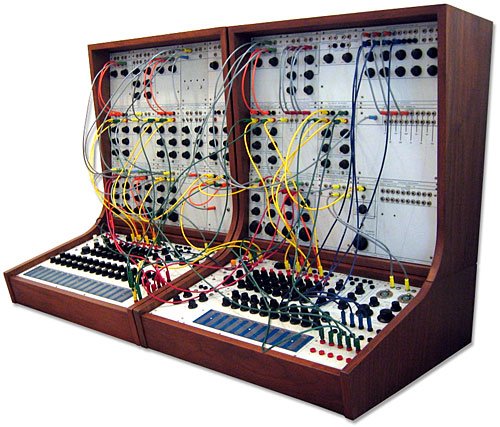 In the early 60s, Subotnick taught at Mills College and with Ramon
Sender, co-founded the San Francisco Tape Music Center. During this period
he collaborated with Anna Halprin in two works
(the 3 legged stool and Parades and changes) and was music
director of the Actors Workshop. It was also during
this period that Subotnick worked with Buchla on what may have been the first
analog synthesizer (now at the Library
of Congress, and shown at right).
In the early 60s, Subotnick taught at Mills College and with Ramon
Sender, co-founded the San Francisco Tape Music Center. During this period
he collaborated with Anna Halprin in two works
(the 3 legged stool and Parades and changes) and was music
director of the Actors Workshop. It was also during
this period that Subotnick worked with Buchla on what may have been the first
analog synthesizer (now at the Library
of Congress, and shown at right).
In 1966 Subotnick was instrumental
in getting a Rockefeller Grant to join the Tape Center with
the Mills Chamber Players (a chamber at Mills College with performers
Nate Rubin, violin; Bonnie Hampton, cello; Naomi Sparrow,
piano and Subotnick, clarinet). The grant required that the
Tape Center relocate to a host institution that became Mills College.
Subotnick, however, did not stay with the move, but went to NY
with the Actor’s Workshop to become the first music director
of the Lincoln Center Rep Company in the Vivian Beaumont Theater
at Lincoln Center. He
also, along with Len Lye, became an artist in residence at the newly
formed Tisch School of the Arts
at NYU. The School of the Arts provided him with a studio and a Buchla
Synthesizer. During this period he helped develop
and became artistic director of the Electric Circus and the Electric
Ear. This was also
the time of the creation of Silver Apples of the Moon, The Wild Bull
and Touch.
[The following is by Christian
Hertzog from Contemporary Composers]
“The work which brought Subotnick celebrity was
Silver Apples of the Moon. Written in 1967 using the Buchla modular synthesizer (an electronic
instrument built by Donald Buchla utilizing
suggestions from Subotnick and Ramon Sender), this work
contains synthesized tone colors, striking for its day,
and a control over pitch that many other contemporary electronic
composers had relinquished. There is a rich counterpoint of
gestures, in marked contrast to the simple surfaces of much
contemporary electronic music. There are sections marked by very clear
pulses, another unusual trait for its time; Silver Apples of
the Moon was commissioned by Nonesuch Records, marking the first
time an original large-scale composition had been created specifically
for the disc medium - a conscious acknowledgment that the
home stereo system constituted a present-day form of chamber music.
Subotnick wrote this piece (and subsequent record company commissions)
in two parts to correspond to the two sides of an LP. The exciting,
exotic timbres and the dance inspiring rhythms caught the
ear of the public -- the record was an American bestseller in
the classical music category, an extremely unusual occurrence for
any contemporary concert music at the time. It has been re-released
on Wergo cd
with The Wild Bull.
The next eight years saw the
production of several more important compositions for LP, realized
on the Buchla synthesizer: The Wild Bull,
Touch, Sidewinder and Four Butterflies.
All of these pieces are marked by sophisticated timbres, contrapuntal
rich textures, and sections of continuous pulse suggesting dance. In
fact, Silver Apples of the Moon was used as dance music by several
companies including the Stuttgart Ballet and Ballet Rambert and The Wild Bull, A Sky of Cloudless
Sulfur and The Key to Songs, have been choreographed by leading
dance companies throughout the world.”
In 1969 Subotnick was invited
be part of a team of artists to move to Los Angeles to plan
a new school. Mel Powell as Dean and Subotnick as Associate
Dean and the team of four other pairs of artists carved out a new
path of music education and created the now famous California Institute
of the Arts. Subotnick remained Associate Dean of the
music school for 4 years and then, resigning as Associate Dean,
became the head of the composition program where, a few years
later, he created a new media program that introduced interactive
technology and multi-media into the curriculum. In 1978
Subotnick, with Roger
Reynolds and Bernard
Rands, produced 5
annual internationally acclaimed new music festivals.
“In 1975, fulfilling another
record company commission, (this time, Odyssey) Subotnick
composed Until Spring, a work for solo synthesizer.
In this work, changes in settings which Subotnick
made in real time on the synthesizer were stored as control voltages
on a separate tape, enabling him to duplicate any of his performance
controls, and to subsequently modify them if he felt the desire
to do so. While the use of control voltages was nothing new, it
suggested to Subotnick a means to gain exact control over real-time electronic
processing equipment.
The next step in Subotnick's use of control voltages was the development
of the "ghost" box. This is a fairly simple electronic device,
consisting of a pitch and envelope follower for a live signal,
and the following voltage-controlled units: an amplifier, a frequency
shifter, and a ring modulator. The control voltages for the
ghost box were originally stored on a tape, updated now to E-PROM.
A performer, whose miced
signal is sent into the ghost box, can then be processed
by playing back the pre-recorded tape or E-PROM, containing the
control voltages. As neither the tape nor E-PROM produce sound,
Subotnick refers to their sound modification as a "ghost score".
By providing the performer with exact timings, co-ordination
between performer and the ghost score is controlled.
Two Life Histories (1977)
was the first piece involving an electronic ghost score; the
bulk of Subotnick's output for the next
six years was devoted to compositions involving performers and
ghost scores. Some of the more notable works in this series include Liquid
Strata (piano), Parallel Lines (piccolo accompanied by nine
players), The Wild Beasts (trombone and piano), Axolotl (solo
cello), The Last Dream of the Beast (solo voice) and The Fluttering
of Wings (string quartet). The subtlety, sophistication and
control over real-time electronic processing that Subotnick
demonstrated in these innovative works secured his reputation as one of
the world's most important electronic music composers.
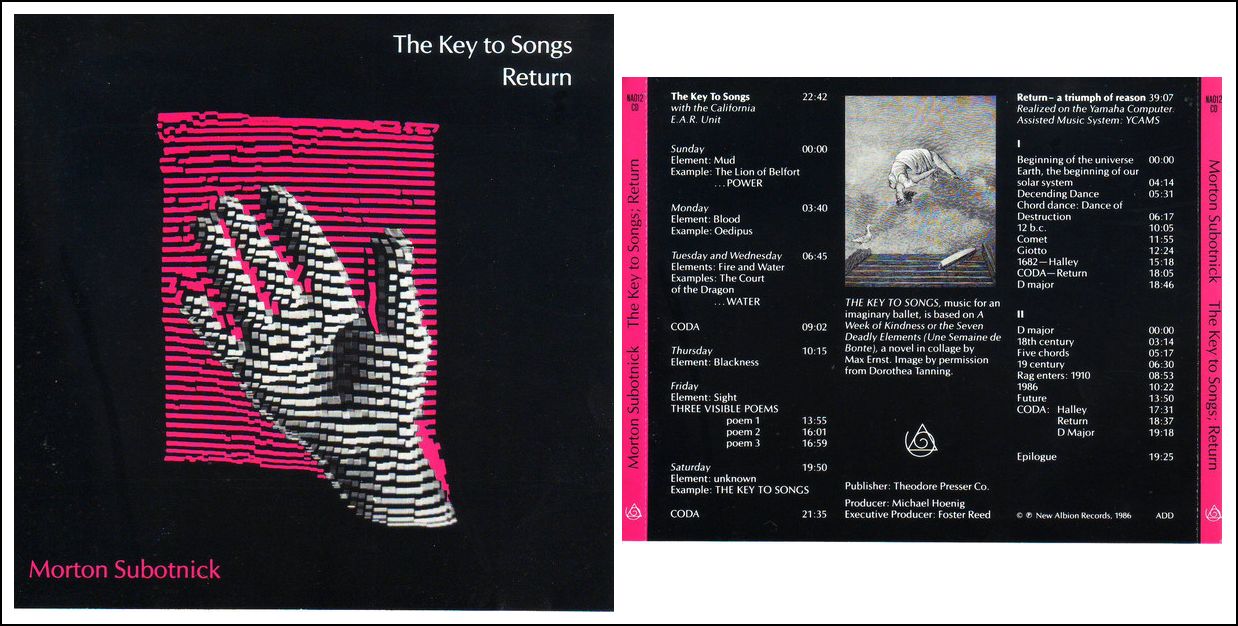
Subotnick reached the apex
of live electronic processing in his work Ascent Into Air
(1981). Written for the powerful 4C computer at IRCAM, this
piece involved many of the techniques
which Subotnick had developed in his ghost scores. In addition
to the processing normally available to him with his ghost
boxes, Subotnick was able to spatially locate sounds in a quadraphonic
field and to modulate the timbres of the instruments. But perhaps
the most significant aspect of this work is its use of live performers
to control the computer music; the live performers, in effect,
serve as "control voltages" to influence where a sound is placed,
how it is modulated and by how much, etc. -- the reverse situation of
the ghost score compositions. Even more remarkable is the ability of
traditional musical instruments to control computer generated sounds.”
In addition to music in the
electronic medium, Subotnick has written for symphony orchestra,
chamber ensembles, theater and multimedia
productions. His "staged tone poem"The Double Life of Amphibians,
a collaboration
with director Lee Breuer and visual artist Irving Petlin, utilizing live interaction between
singers, instrumentalists and computer, was premiered at the
1984 Olympics Arts Festival in Los Angeles.
The concert version of Jacob's
Room, a
mono drama commissioned by Betty Freeman
for the Kronos Quartet and singer Joan
La Barbara, received its premiere in San Francisco in 1985. Jacob's
Room, Subotnick's multimedia opera chamber
opera (directed by Herbert Blau with video
imagery by Steina and Woody Vasulka, featuring Joan La Barbara), received
its premiere in Philadelphia in April 1993 under the auspices
of The American Music Theater Festival. The Key to Songs, for chamber orchestra
and computer, was premiered at the 1985 Aspen Music Festival. Return, commissioned
to celebrate the return of Haley's Comet, premiered with an accompanying
sky show in the planetarium of Griffith Observatory in Los Angeles
in 1986. Subotnick's recent works utilize computerized
sound generation, specially designed software Interactor
and "intelligent" computer controls which allow the performers
to interact with the computer technology.
All My Hummingbirds Have Alibis
(1994) was an interactive concert work and a CDROM (perhaps the first of its kind),
Making Music (1995), Making More Music (1998) were his first
works for children, and an interactive 'Media Poem', Intimate Immensity,
premiered at the Lincoln Center Festival in NY (1997). The European
premiere (1998) was in Karlsrhue, Germany. A string quartet with CDROM,
"Echoes from the Silent Call of Girona" (1998), was premiered
in Los Angeles by Southwest Chamber Music.
Subotnick is also doing pioneering
work to offer musical creative tools to young children. He
has authored a series of six CDROMs for children, a children's
website [creatingmusic.com] and developing a program for classroom
and after school programs that will soon become available internationally.
These works are available from Alfred Music Publishers.
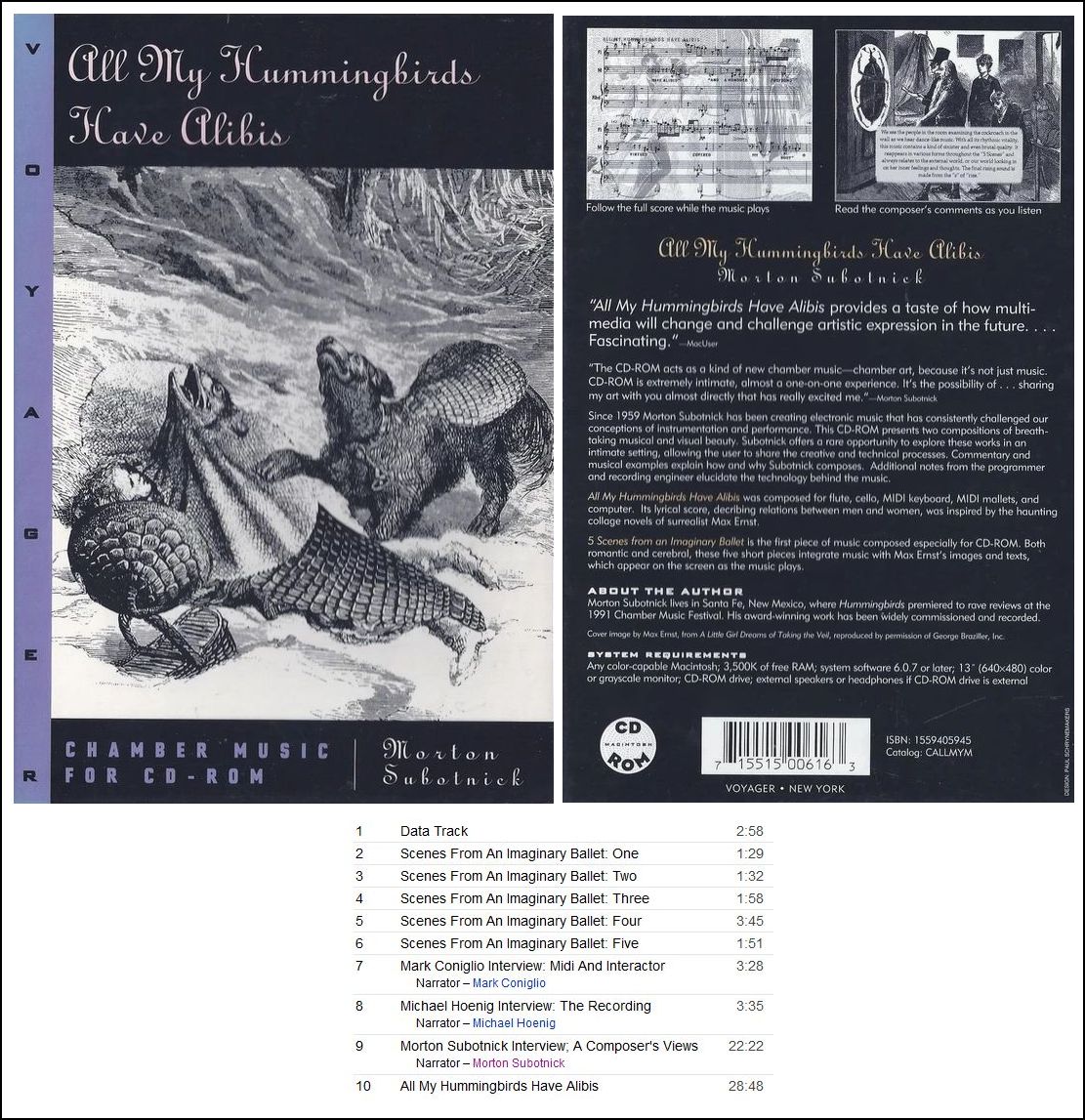
At present (2010) he is developing
a music curriculum for young children. The curriculum centers
around the creating music. The child
will learn from creating original music. He
has been commissioned to complete the larger version of the
opera, Jacob’s Room. This will be
premiered in 2010 at the Begenz Festival in Austria. He is also working closely with the
Library of Congress as they are preparing
an archival presentation of his electronic works.
He tours extensively throughout the U.S. and Europe as a
lecturer and composer/performer. Morton Subotnick is published by Schott Music.
== Text
(only) slightly edited from the composer's official website; photos added
for this presentation
|
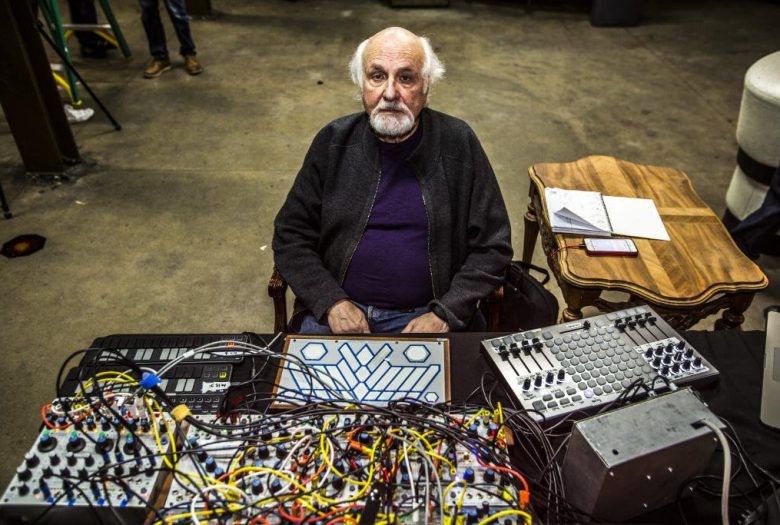
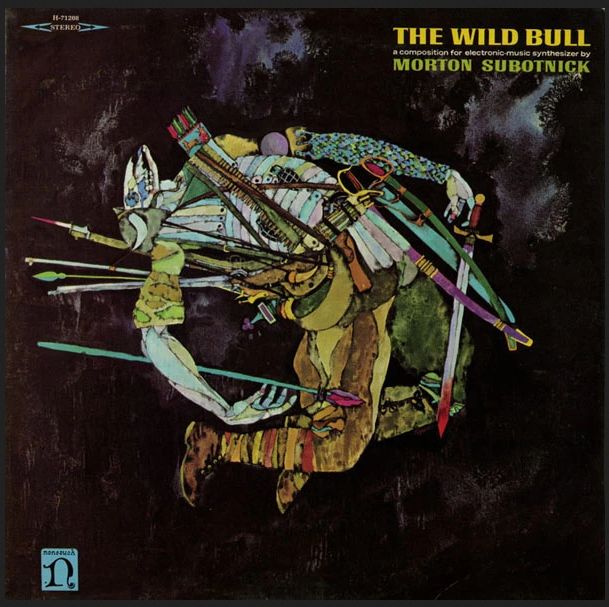 MORTON SUBOTNICK (born in Los Angeles, California, April 14, 1933) is
one of the acknowledged pioneers in the field of electronic music
and an innovator in works involving instruments and other media.
He was the first composer to be commissioned to write an electronic
composition expressly for the phonograph medium, Silver Apples
of the Moon (Nonesuch, 1967). [Photo of LP jacket is shown
farther down on this webpage.] This now classic work and The Wild
Bull (also an electronic commission for Nonesuch, 1968, shown
at right) have been choreographed by leading dance companies
throughout the world and remain in permanent repertory.
MORTON SUBOTNICK (born in Los Angeles, California, April 14, 1933) is
one of the acknowledged pioneers in the field of electronic music
and an innovator in works involving instruments and other media.
He was the first composer to be commissioned to write an electronic
composition expressly for the phonograph medium, Silver Apples
of the Moon (Nonesuch, 1967). [Photo of LP jacket is shown
farther down on this webpage.] This now classic work and The Wild
Bull (also an electronic commission for Nonesuch, 1968, shown
at right) have been choreographed by leading dance companies
throughout the world and remain in permanent repertory.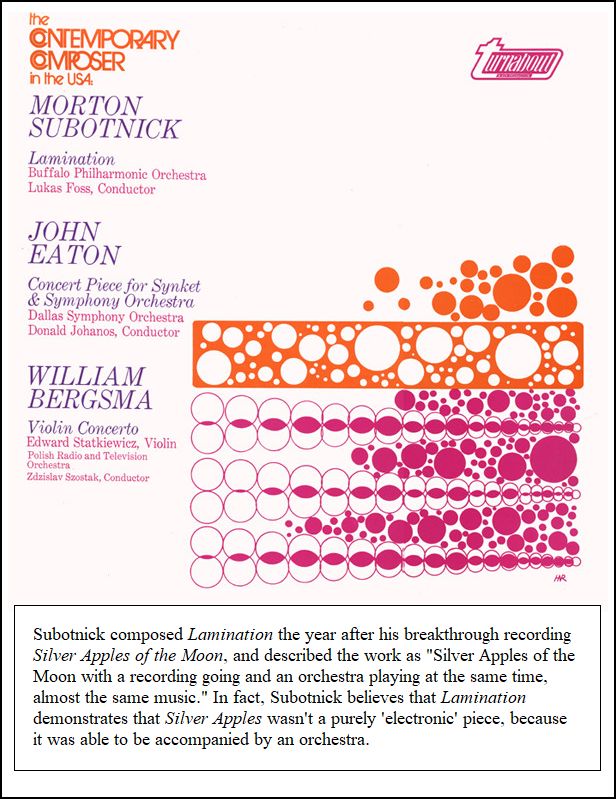 Bruce Duffie: We’ll start with a really easy question.
Where’s music going these days? [Both laugh]
Bruce Duffie: We’ll start with a really easy question.
Where’s music going these days? [Both laugh]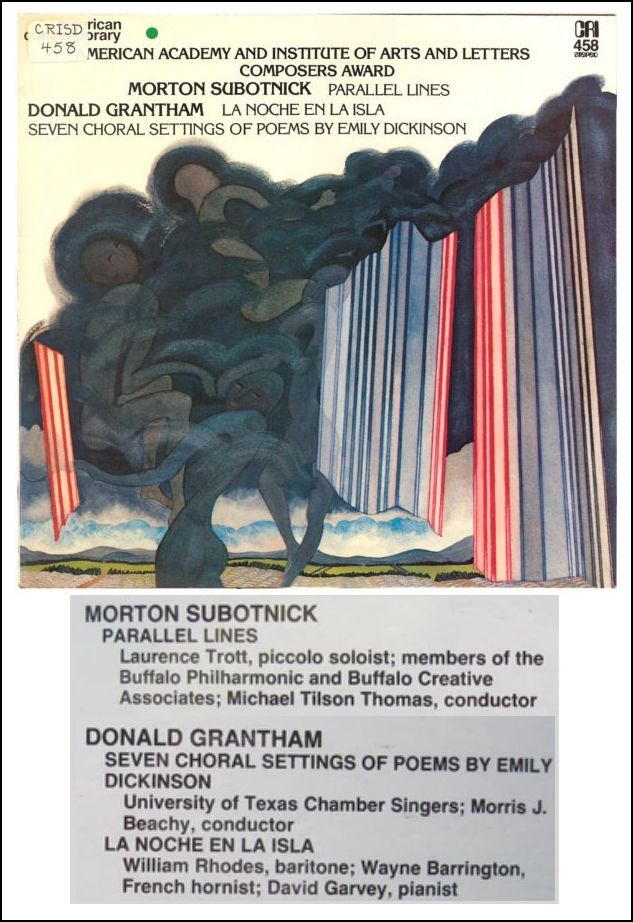 BD: But it never caught on!
BD: But it never caught on!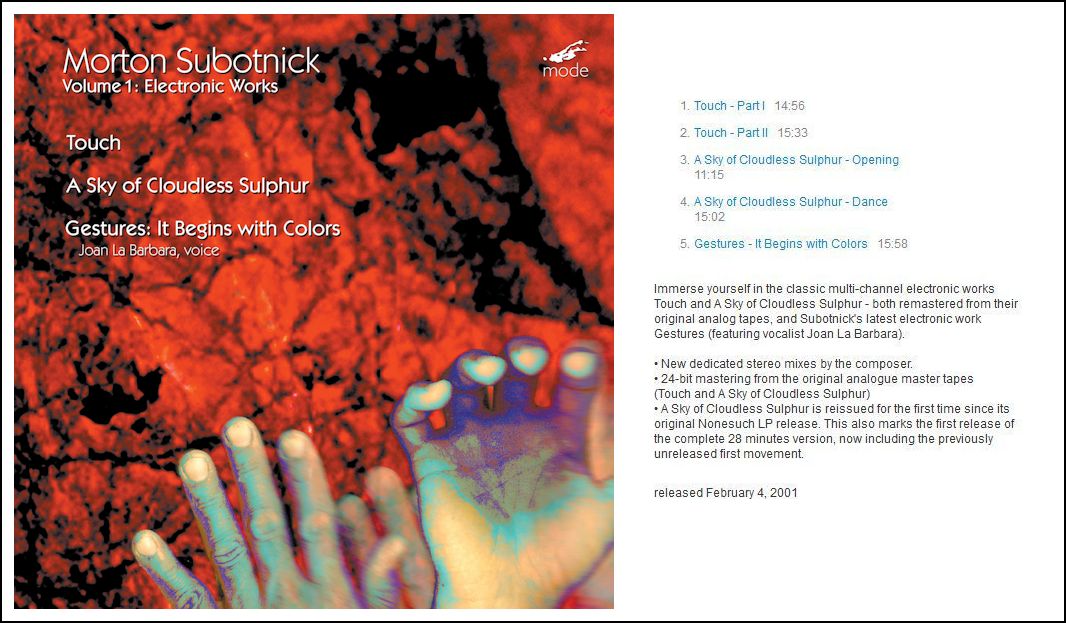
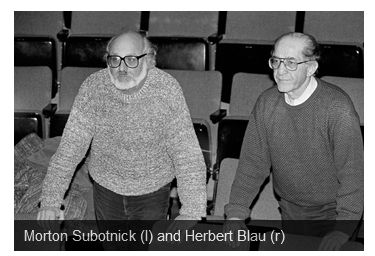 As co-founder (with Jules Irving) of The Actor's Workshop
in San Francisco (1952–1965) and co-director of the Repertory Theater
of Lincoln Center in New York City (1965–67), Blau introduced American
audiences to avant garde drama in some of the country's first
productions of Samuel Beckett, Jean Genet, and Harold Pinter including
the 1957 performance of Beckett's Waiting for Godot at California's
San Quentin State Prison. [Photo at right was taken during rehearsals
for a production of Jacob's Room at the University of Wisconsin-Milwaukee,
early in 1994.]
As co-founder (with Jules Irving) of The Actor's Workshop
in San Francisco (1952–1965) and co-director of the Repertory Theater
of Lincoln Center in New York City (1965–67), Blau introduced American
audiences to avant garde drama in some of the country's first
productions of Samuel Beckett, Jean Genet, and Harold Pinter including
the 1957 performance of Beckett's Waiting for Godot at California's
San Quentin State Prison. [Photo at right was taken during rehearsals
for a production of Jacob's Room at the University of Wisconsin-Milwaukee,
early in 1994.] 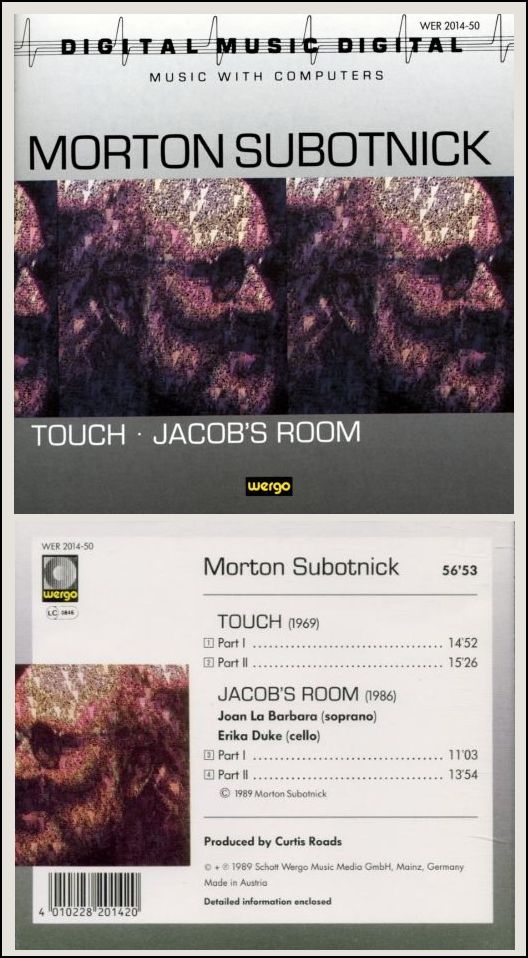 Subotnick: That was more of what they were expecting.
I finally felt that I had clearly seen my vision, and knew what I
needed to do. For me, that was a personal vision of merging language,
image, and music together into one thing. I did a theater piece
in San Francisco, about a forty or forty-five-minute work that just had
four lighting flats and four musicians, two tape recorders, and a person
who spoke. I used a Michael McClure poem called The Flower of
Politics, and it was extremely well-received. The audience loved
it. It was performed four times, and the San Francisco paper sent
their two critics, so each performance had a review. It was a real
smash, and I felt this was clearly what I needed to do. But I didn’t
have a handle on each of these things. The electronics were crude.
Lighting flats are really a crude way to do it, and so I decided I would
take the next several years and separate all the media, and do some film
work. Later it was video, and I tried to get the electronics more under
control. I wanted to see what instruments meant to me in the context
of the theater, rather than just a straight instrumental route and language.
Jacob’s Room is the culmination of those efforts. It’s
taken a long time, but I also did a number of theater pieces that were
very good. There were two big ones that included images, but they
didn’t include language. I felt that I wasn’t completing this gestalt
[an organized whole that is perceived as more than the sum of its parts]
until I actually said something verbally. You can see that in the
5 Scenes [a slide show presented on the same Ravinia concert earlier
that evening]. There’s verbal content that has been the most difficult
for me to introduce into it, and still keep the integrity of the musical
experience. The visuals with Jacob’s Room are the language
of memory for me. When he says at the beginning, “When
perfect and fully winged, and the soul soars upward and puts order to
the whole world,” it took us four hours to get
the word ‘order’ recorded right. When he says the word ‘order’, there’s
a strange cloud in the sky at that moment in the theater. It’s
all black and white, but it hangs behind this black scrim. It’s just
sitting there, and he says the word ‘order’. The cloud turns, and
you see it’s a cloud from a bomb. Then you see people running underneath.
It’s about a five-second thing, and that sets
up the whole imagery for the piece. Then he’s trying to block this
out, but there are certain images you cannot block out. The memory
keeps coming no matter what the words say. It’s stuff that keeps coming
back, and I used the image as the language of memory throughout the entire
piece. The integration between all the stuff is really complete, and
I finally did it. Except for the lullaby at the beginning, she never
sings a word. She only speaks words, and when she sings a lot of people
don’t realize that that’s the truth because when it’s done, it all melts
together. In fact, she only speaks the stories, and she sings for
emotion. It’s this constant thing, and that was my way of treating
the words with a kind of dignity that they needed, and still having the
musical experience. You have the words, and you have the music
— which is almost the original concept in opera,
where all the important things were done over a recitative. Then you
sang your aria, in which you didn’t care what the words were. It was
the emotion that was going. Instead of breaking my work up into
arias and recitative, it’s all one fabric, but it’s back-and-forth all
the time. I can’t tell you how many people don’t realize it until
after they’ve seen the production, and I tell them. They say, “It’s
not true!”, which is good.
Subotnick: That was more of what they were expecting.
I finally felt that I had clearly seen my vision, and knew what I
needed to do. For me, that was a personal vision of merging language,
image, and music together into one thing. I did a theater piece
in San Francisco, about a forty or forty-five-minute work that just had
four lighting flats and four musicians, two tape recorders, and a person
who spoke. I used a Michael McClure poem called The Flower of
Politics, and it was extremely well-received. The audience loved
it. It was performed four times, and the San Francisco paper sent
their two critics, so each performance had a review. It was a real
smash, and I felt this was clearly what I needed to do. But I didn’t
have a handle on each of these things. The electronics were crude.
Lighting flats are really a crude way to do it, and so I decided I would
take the next several years and separate all the media, and do some film
work. Later it was video, and I tried to get the electronics more under
control. I wanted to see what instruments meant to me in the context
of the theater, rather than just a straight instrumental route and language.
Jacob’s Room is the culmination of those efforts. It’s
taken a long time, but I also did a number of theater pieces that were
very good. There were two big ones that included images, but they
didn’t include language. I felt that I wasn’t completing this gestalt
[an organized whole that is perceived as more than the sum of its parts]
until I actually said something verbally. You can see that in the
5 Scenes [a slide show presented on the same Ravinia concert earlier
that evening]. There’s verbal content that has been the most difficult
for me to introduce into it, and still keep the integrity of the musical
experience. The visuals with Jacob’s Room are the language
of memory for me. When he says at the beginning, “When
perfect and fully winged, and the soul soars upward and puts order to
the whole world,” it took us four hours to get
the word ‘order’ recorded right. When he says the word ‘order’, there’s
a strange cloud in the sky at that moment in the theater. It’s
all black and white, but it hangs behind this black scrim. It’s just
sitting there, and he says the word ‘order’. The cloud turns, and
you see it’s a cloud from a bomb. Then you see people running underneath.
It’s about a five-second thing, and that sets
up the whole imagery for the piece. Then he’s trying to block this
out, but there are certain images you cannot block out. The memory
keeps coming no matter what the words say. It’s stuff that keeps coming
back, and I used the image as the language of memory throughout the entire
piece. The integration between all the stuff is really complete, and
I finally did it. Except for the lullaby at the beginning, she never
sings a word. She only speaks words, and when she sings a lot of people
don’t realize that that’s the truth because when it’s done, it all melts
together. In fact, she only speaks the stories, and she sings for
emotion. It’s this constant thing, and that was my way of treating
the words with a kind of dignity that they needed, and still having the
musical experience. You have the words, and you have the music
— which is almost the original concept in opera,
where all the important things were done over a recitative. Then you
sang your aria, in which you didn’t care what the words were. It was
the emotion that was going. Instead of breaking my work up into
arias and recitative, it’s all one fabric, but it’s back-and-forth all
the time. I can’t tell you how many people don’t realize it until
after they’ve seen the production, and I tell them. They say, “It’s
not true!”, which is good.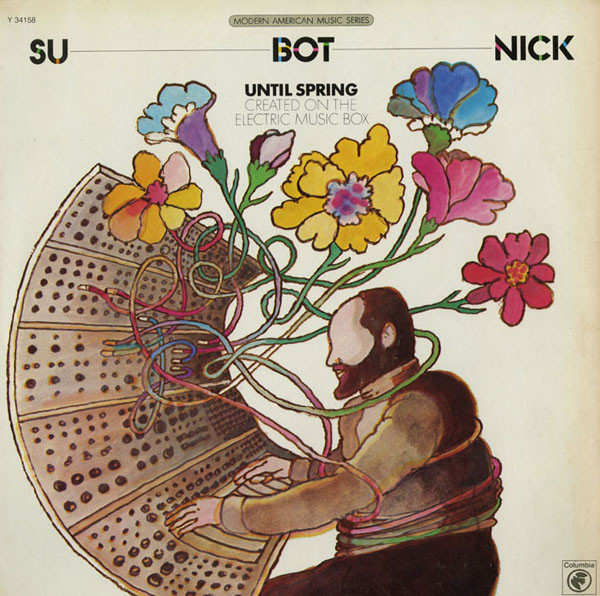 BD: Let me ask another easy question. What’s the
purpose of music?
BD: Let me ask another easy question. What’s the
purpose of music?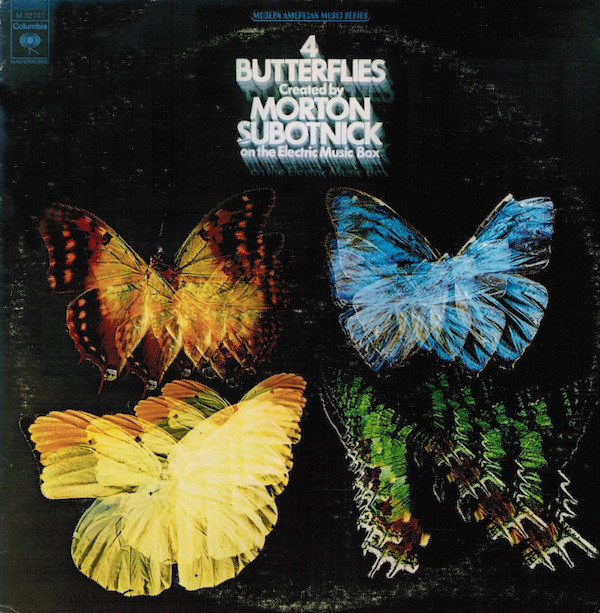
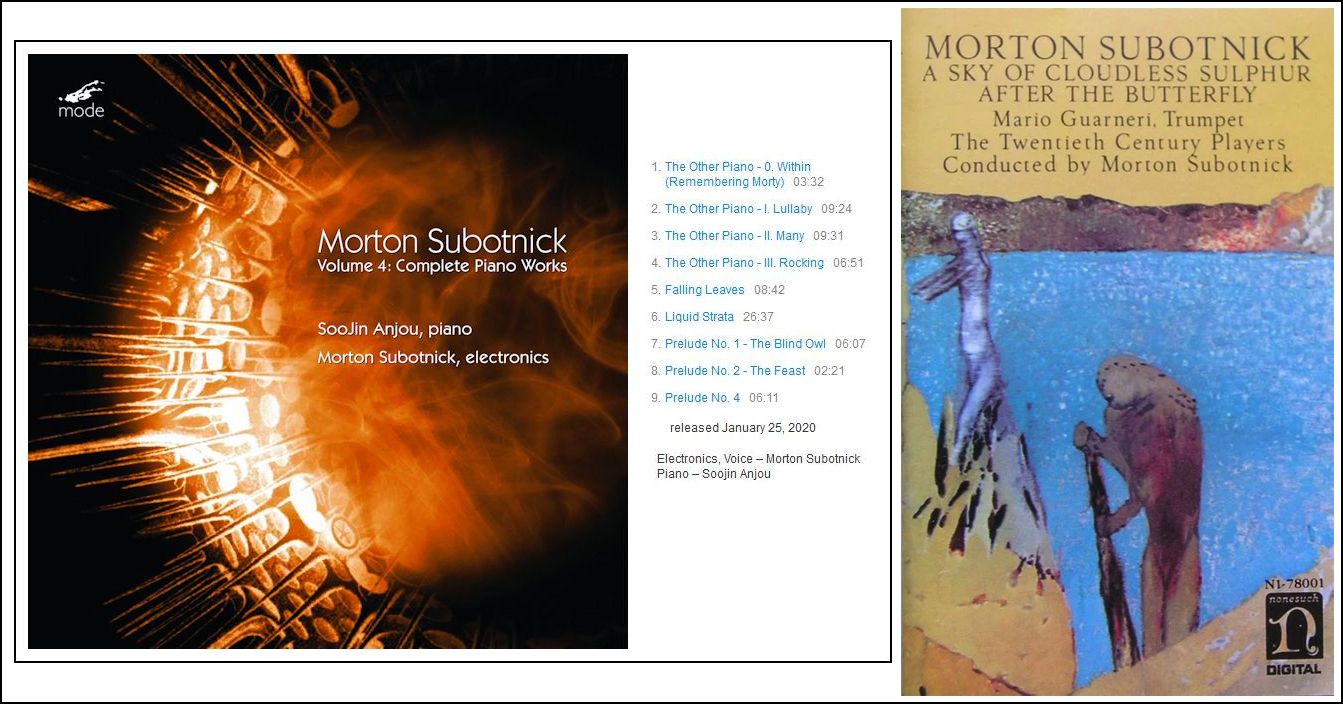
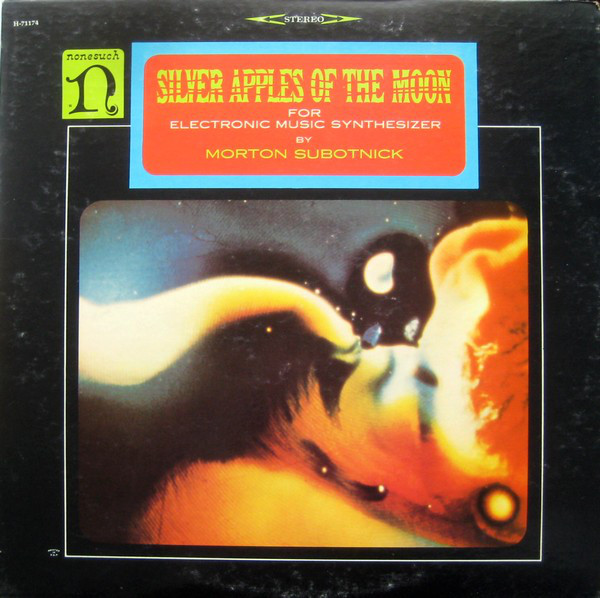
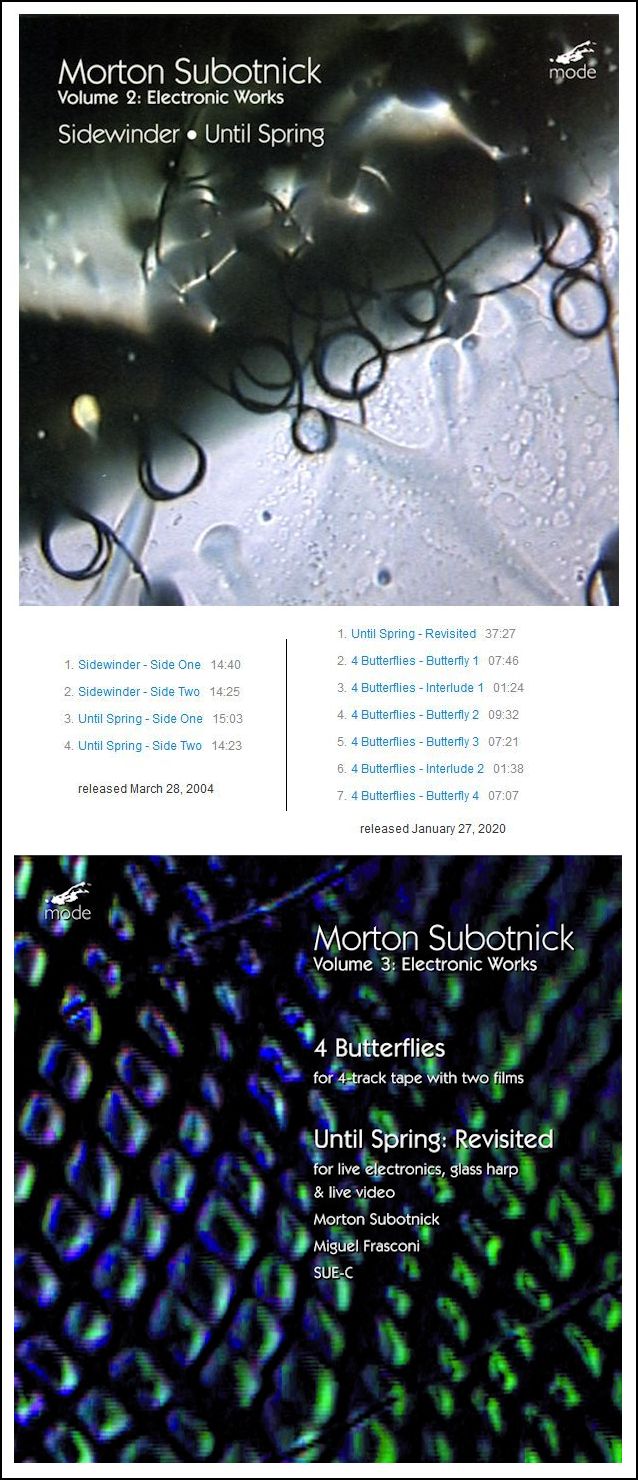 Subotnick: Right, and I didn’t ever expect
it really to happen. I have a piece, which I wrote for orchestra,
which uses the recording studio as a metaphor. It’s a very pretty
piece, and very difficult to perform. The Los Angeles Philharmonic
did it, and Zubin Mehta
conducted it. It divides the orchestra into small groups.
They’re on the stage in the usual way, but microphones are placed between
three to four people all the way through the orchestra. There are
twelve violins with practice mutes who are controlling their stations.
Each of them is controlling the amplification, so, at a certain moment,
when the conductor gives a down-beat, you can get the attack of a flute
and the after-effect and the decay of a harp. This is because
this violinist plucks at the same time the flautist plays, so you hear
the flute for the duration of a pluck, and then a crescendo on the harp
in another part. You never hear the violinists because they’ve got
these practice mutes on, but they’re literally controlling the electronics.
[Musing on the future] It won’t happen gradually... it will
happen suddenly, in probably ten or fifteen years, but when the electronics
are there, a lot of composers will say they have this idea. It’s a
perfectly logical idea, but the reason we haven’t thought about it now
is because people haven’t made the connection of where the technology is
going. It was clear to me at that time. I figured out these pieces
when I wrote them. They were all done. They were commissioned,
and I got them done, but they didn’t get played very much because of the
complication of trying to produce them. I figured once the technology
was there, fine. When I would go into an auditorium, I used to have
to fight the technology. I don’t do that anymore. The sound
is beautiful. I used to be killing people to get the right speakers,
and now every auditorium has them.
Subotnick: Right, and I didn’t ever expect
it really to happen. I have a piece, which I wrote for orchestra,
which uses the recording studio as a metaphor. It’s a very pretty
piece, and very difficult to perform. The Los Angeles Philharmonic
did it, and Zubin Mehta
conducted it. It divides the orchestra into small groups.
They’re on the stage in the usual way, but microphones are placed between
three to four people all the way through the orchestra. There are
twelve violins with practice mutes who are controlling their stations.
Each of them is controlling the amplification, so, at a certain moment,
when the conductor gives a down-beat, you can get the attack of a flute
and the after-effect and the decay of a harp. This is because
this violinist plucks at the same time the flautist plays, so you hear
the flute for the duration of a pluck, and then a crescendo on the harp
in another part. You never hear the violinists because they’ve got
these practice mutes on, but they’re literally controlling the electronics.
[Musing on the future] It won’t happen gradually... it will
happen suddenly, in probably ten or fifteen years, but when the electronics
are there, a lot of composers will say they have this idea. It’s a
perfectly logical idea, but the reason we haven’t thought about it now
is because people haven’t made the connection of where the technology is
going. It was clear to me at that time. I figured out these pieces
when I wrote them. They were all done. They were commissioned,
and I got them done, but they didn’t get played very much because of the
complication of trying to produce them. I figured once the technology
was there, fine. When I would go into an auditorium, I used to have
to fight the technology. I don’t do that anymore. The sound
is beautiful. I used to be killing people to get the right speakers,
and now every auditorium has them.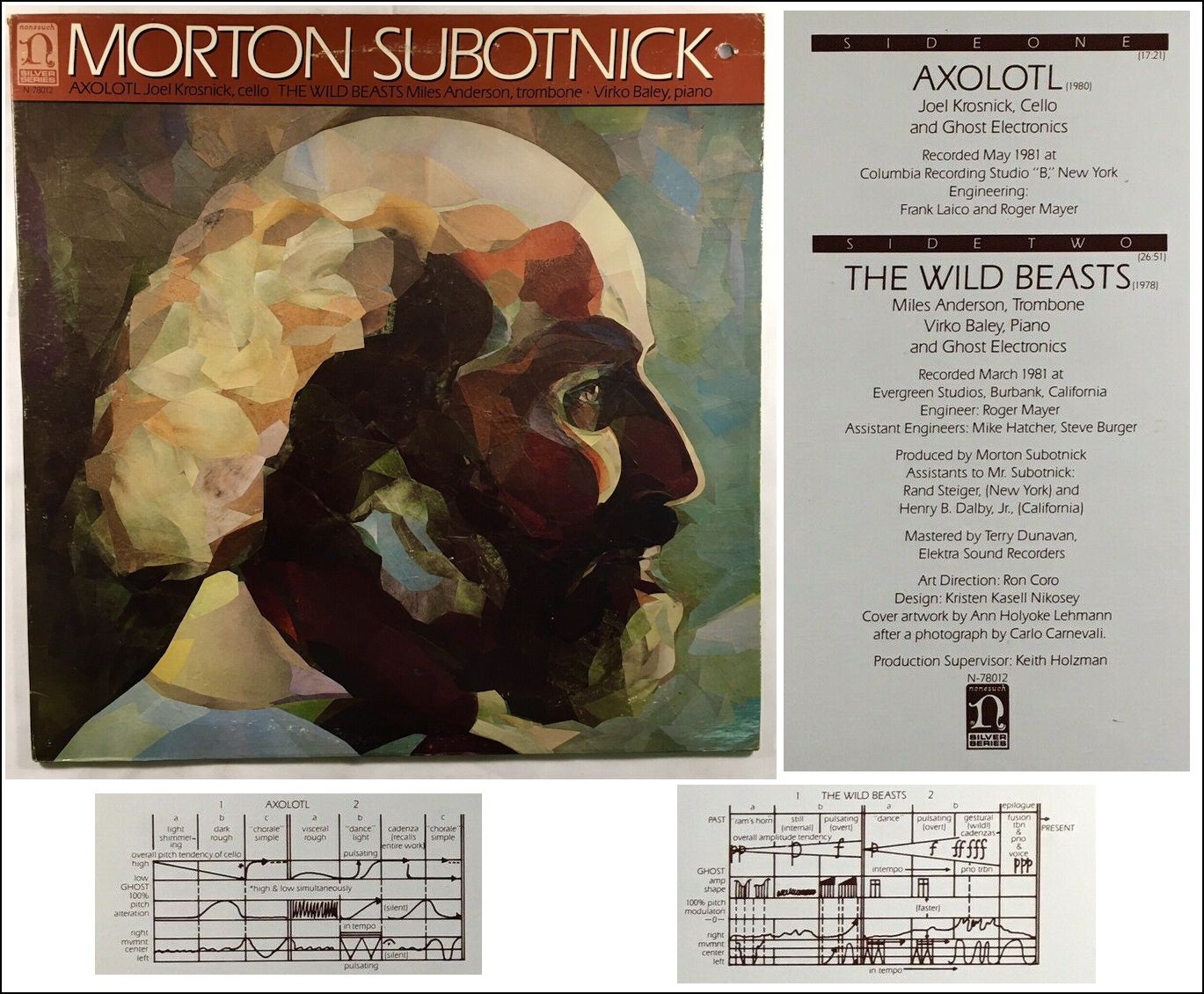
 In the early 60s, Subotnick taught at Mills College and with Ramon
Sender, co-founded the San Francisco Tape Music Center. During this period
he collaborated with Anna
In the early 60s, Subotnick taught at Mills College and with Ramon
Sender, co-founded the San Francisco Tape Music Center. During this period
he collaborated with Anna 
